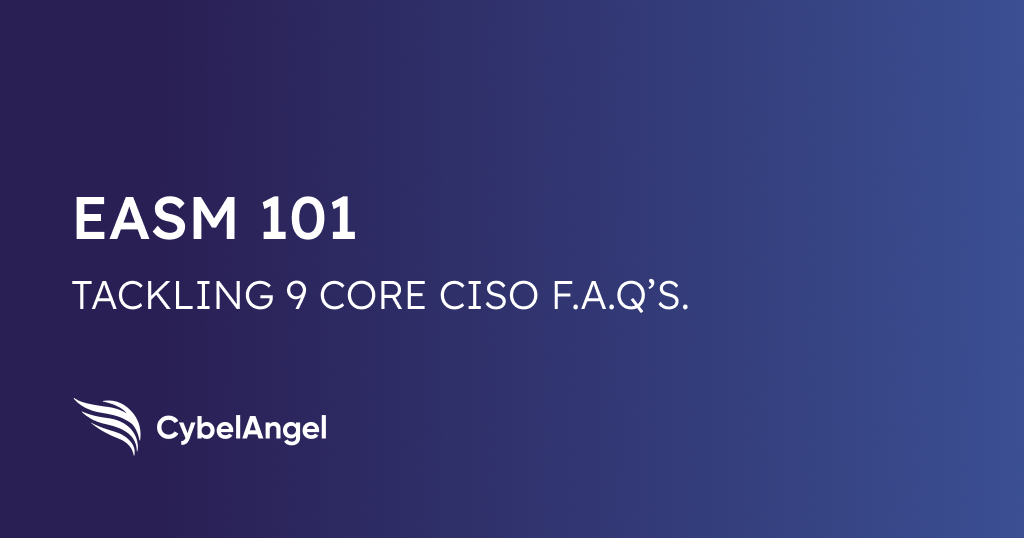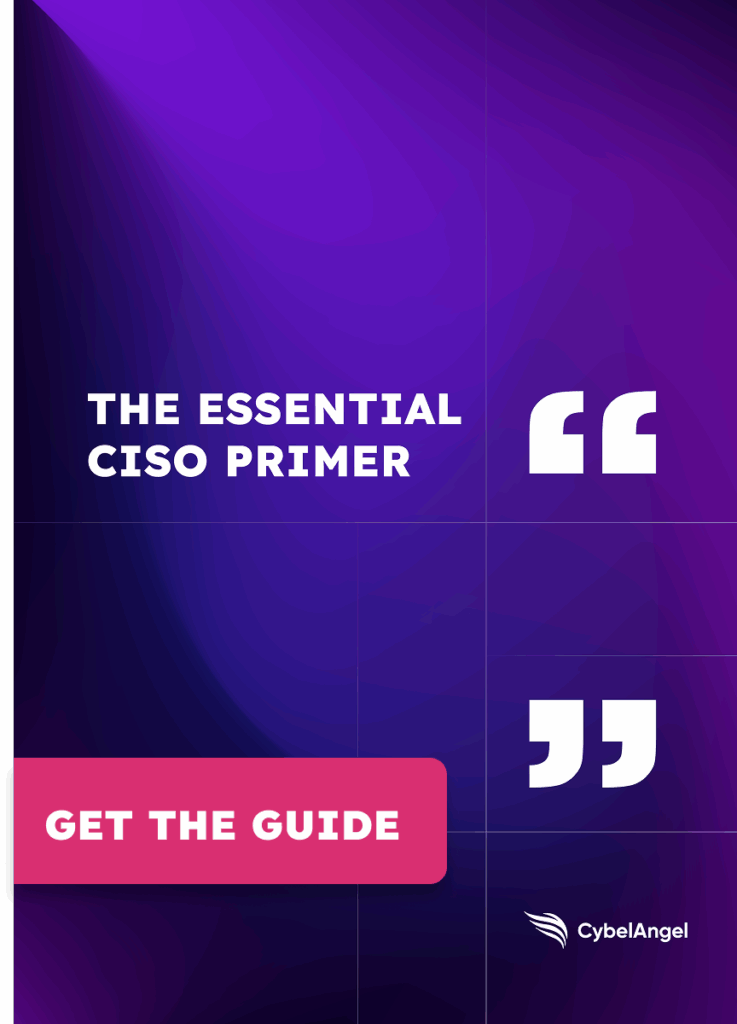9 FAQs [For CISOs]

Table of contents
External attack surface management (EASM) has become a critical aspect of cybersecurity.
With CISOs on the frontline to protect their organizations from external threats, here are 9 in-depth FAQs to effectively navigate the world of EASM.
From the definition of EASM, to the best practices for its implementation, here’s everything CISOs need to know to boost their organization’s security posture.
1. What is external attack surface management (EASM)?
What is EASM, or external attack surface management? EASM is the process of identifying, monitoring, and safeguarding all external-facing (public) assets.
With EASM, CISOs can identify any misconfigurations or vulnerabilities in real-time, helping them to anticipate and prevent hackers from taking advantage. In short, it’s the ultimate cyber threat intelligence tool.
EASM involves understanding the key components of an organization’s attack surface, which include Internet-facing assets such as:
- Websites
- Social media accounts
- Web applications
- APIs and endpoints
- Public cloud services
- DNS records
- Email servers
- Internet of Things (IoT)
By safeguarding all of these assets, security teams can avoid cyber threats before they happen.
2. What’s the difference between EASM and ASM?
EASM (external attack surface management) and ASM (attack surface management) both give an overview of an organization’s attack surface. However, there are some small differences between the two.
- EASM: Focuses exclusively on external-facing digital assets and vulnerabilities
- ASM: Gives a wider overview of all potential attack vectors, including both external and internal network vulnerabilities
If CISOs want to prioritize both internal and external threats, then an ASM strategy could be a good fit. However, EASM works well for anyone who simply wants to focus on external threats, such as from hackers and ransomware groups.
3. How is EASM security implemented?
There are five key steps to identify and manage exposed assets in any organization, using EASM vendors such as CybelAngel.
- Asset discovery and monitoring: Gain a full asset inventory, including previously unknown assets and shadow IT.
- Data breach prevention: Proactively discover any data leaks before they can be exploited.
- Account takeover prevention: Prevent stolen login credentials from being sold on the dark web.
- Dark web monitoring: Follow underground cybercriminal message boards to anticipate and prevent cyber attacks.
- Domain protection: Remove fraudulent sites using your domain name before they damage your reputation.
Once organizations fully understand their digital footprint, they can take steps to neutralize and reduce potential attack vectors against them.
Ultimately, EASM is a preventative form of risk management, helping people to proactively avoid cyber attacks, instead of simply reacting to them when they happen.
4. Why is EASM so critical for CISOs?
With effective asset discovery and continuous monitoring, CISOs can proactively reduce their attack surface and avoid any unpleasant surprises from threat actors.
Here are five reasons why EASM is so essential for CISOs everywhere.
- Boost risk management: By understanding potential vulnerabilities, CISOs can implement the necessary security tools and measures to resolve them.
- Stay compliant: Protecting an organization’s ecosystem helps them to stay compliant with data protection laws and industry standards (more on this later).
- Safeguard sensitive data: Personal data, ecosystems, and configurations can be protected from exploitation or unauthorized access.
- Have a better incident response plan: With external attack surface monitoring, CISOs can develop more robust incident response plans and use cases.
- Guarantee business continuity: With effective EASM measures, organizations can be more resilient against cyber threats and maintain their usual business operations.
Plus, the financial perks are worth the effort. (Take a look at the next section to see why…)
5. What are the financial benefits of EASM cybersecurity?
Prevention is better (and cheaper) than cure!
Here are the economic benefits of external attack surface management, using data from EASM vendor CybelAngel as an example. This data was gathered via a report from Forrester.
- Thanks to EASM, you can save 10% in cyber insurance premiums
- You can get 359% ROI over three years
- You can avoid data breaches with a potential cost of $2.1 million
- With EASM technology, you don’t need to hire extra employees, leading to an additional $860,000 in savings over three years
The bottom line—investing in EASM tools is a smart financial decision in the long run.
But what happens if CISOs don’t use EASM?
6. What are some recent examples of EASM cyber attacks?
Let’s look at some real-life use cases of what happens when EASM solutions aren’t prioritized, as detailed in CybelAngel’s 2024 report.
But in the meantime, as a quick overview, poor EASM measures can lead to…
- Data breaches: MOVEit, a secure file transfer software, suffered a mass hack that exposed the personal data of 84 million individuals and cost the company $10 billion.
- Increased scope for human error: DarkBeam, a digital risk protection company, accidentally exposed 3.8 billion records due to an unprotected database.
- Ransomware takeovers: Independent Living Systems (ILS), a healthcare administration service, suffered a data breach of over 4.2 million people after someone gained unauthorized access to their systems.
- Infostealers: TMX Finance, a parent company of several brands, exposed the data of 4.8 million people due to someone gaining unauthorized access and exporting information from their computer system.
- Cloud exposure: PharMerica Corporation, a pharmaceutical provider, suffered a ransomware attack that exposed the data of 6 million people.
- Third-party exploitation: The MCNA Insurance Company had a data breach that affected 8.9 million people, showing that any provider or supply chain vendor can be exploited.
- Compromised file servers: PeopleConnect Inc. suffered a data breach that compromised their databases of 20 million users via an exposed database backup.
- Exposed assets: T-Mobile suffered a data breach that affected 37 million accounts due to unauthorized access to an API system.
7. What are some best practices when using EASM tools?
When done right, external attack surface management can bring peace of mind and security to any organization. Here are some easy EASM best practices for CISOs to keep in mind.
- Prioritization is key: Effective vulnerability management is all about identifying the most important assets and misconfigurations and securing those first. Make sure you prioritize your digital assets and focus on the ones with the highest cyber risks.
- Review the sensitive data you process: The more personal data you store, the bigger your attack surface, and the greater the opportunity for cybercriminals. Make sure you’re only keeping essential information, and let go of the rest.
- Train your employees: Even with the best EASM tools on the market, people are usually the weakest link when it comes to cybersecurity. Whether it’s virtual or on-premises training, make sure that everyone in your organization is educated on cybersecurity best practices to reduce the margin for human error.
- Test and audit regularly: Use strategies such as pen testing to spot any vulnerabilities, and audit your incident response plan often to make sure it’s up to date with the latest developments in the cybersecurity world.
- Be open to new cybersecurity technology: A recent Gartner attack surface management report highlighted the importance of embracing emerging technologies to combat the latest cyber threats.
- Stay tuned into the latest EASM insights: Cyber threats are constantly evolving, so CISOs need to, as well. Fortunately, there are lots of resources to follow the latest trends, from Gartner EASM reports to CybelAngel’s 2024 EASM report.
- Get your third-party vendors on board: One external attack surface management Gartner insight was that CISOs need to prioritize supply chain cybersecurity. Otherwise, even if an organization’s security measures are in place, hackers can always target a third-party vendor with weaker protocols.
- Get specialized help with remediation: If your data is compromised, make sure you get support from a reputable external attack surface management vendor. For example, CybelAngel offers remediation services that can reduce your “downtime” by 85%.
8. What laws and regulations are connected to EASM solutions?
External attack surface management doesn’t just help CISOs to safeguard business operations. It also ensures that your organization stays compliant with laws, regulations, and industry standards.
Here are just a few examples.
- PCI DSS: The Payment Card Industry Data Security Standard is a compliance standard for organizations that process card payments
- GDPR: The General Data Protection Regulation is the toughest privacy and security law in the world, founded by the European Union in 2018
- HIPAA: The Health Insurance and Portability Act is a federal data protection law for any organization that processes patient health information
- DPA: The Data Protection Act exists in the UK to safeguard how personal data is processed and managed
- CCPA: The California Consumer Privacy Act is designed to give consumers more autonomy over the processing of their personal information
Using EASM solutions helps companies to safeguard the data they process. More importantly it helps you to avoid the risk of being compromised—which could lead to legal actions, sanctions,fines, and the loss of public trust.
Every CISO is responsible for knowing the legal and regulatory requirements in their geographical region.
9. What’s the future of EASM?
According to Gartner’s 2024 trends report, here are some changes we can expect in the world of cybersecurity and EASM.
- There’s a greater focus on human error: As EASM cybersecurity technology evolves, humans remain the weakest link—meaning that CISOs will place more emphasis on cybersecurity training and awareness
- AI is changing the face of EASM: CISOs and stakeholders have to learn how to incorporate AI technology in a way that’s ethical, safe, and secure
- Cybersecurity is becoming more metrics-focused: CISOs are under increasing pressure to deliver outcome-driven metrics (ODMs) to show the benefits of cybersecurity investment
- Organizations’ attack surfaces are more exposed: As more teams embrace SaaS, digital supply chains, social media and more, the scope for cyber threats is wider than ever
- Third-party cyber risk is a hot topic: Third-party vendors can be another weak link for any company’s EASM, meaning that CISOs will place more emphasis on managing third-party cyber threats
Conclusion
Whether in SaaS, healthcare, government, or otherwise, ASM should be top priority for any organization.
Proactively safeguarding your external-facing assets will prevent more severe problems later down the line. It has also been proven to deliver an ROI of 359% over three years!
When investing in the relevant solutions, remember to:
- Use a trusted external threat intelligence vendor like CybelAngel
- Keep up to date with the latest insights via your preferred external reports from Gartner and Forrester
- Constantly test and audit your cybersecurity strategies to stay ahead
- Focus on the human element of cybersecurity by bringing your employees and third-party vendors on board
Keep these best practices in mind to protect your organization from external threats and safeguard your business operations for the future.


